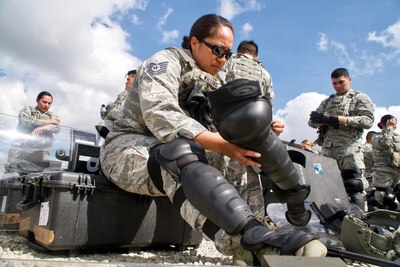By Air Force Senior Airman John Linzmeier, 154th Wing
GULFPORT, Miss., Feb. 20, 2018 — Imagine this: A major
earthquake registering magnitude 7.7 strikes a town called Luxora, Arkansas,
while also affecting a town called Aloha City in Perry County, Mississippi.
There are reports of high amounts of injuries, casualties and major
infrastructure damage throughout Aloha City.
As criminal activity is on the rise in rural areas, the
Mississippi Emergency Management Agency is stretched thin. There isn’t enough
law enforcement support to respond to the looters and to help injured civilians
in hard-to-reach places. The Mississippi governor declared an emergency in
Perry County, and enacted an Emergency Message Action, asking for support of
outside states and local, state and federal agencies to respond to the affected
region.
Disasters like this happen all the time, which is why about
1,000 participants from federal, state and local entities came together here
for this year’s iteration of exercise Patriot South, held Feb. 13-15.
In this particular training scenario, the Hawaii Air
National Guard’s 154th Security Forces Squadron flew 4,200 miles to join
Mississippi law enforcement’s call to arms.
Realistic Training
After the triggering event of Patriot South, the
catastrophic earthquake, the airmen from Hawaii united with the Mississippi
Department of Wildlife, Fisheries and Parks’ Special Response Team at Camp
Shelby, Mississippi, where they were unofficially deputized for the training
events. Over the next three days, the airmen served as much-needed backup for
the responders in a series of trials, such as supply delivery, medical care,
search and rescue, VIP escort, crowd management and even herding cattle in
order to clear an airfield.
“Based off my experience of working with active-duty airmen,
the training we went through felt very realistic,” said Airman 1st Class Marvin
Bumanglag, a 154th SFS fire team member. “Some parts got really stressful, but
as long as we stayed in communication with each other, we were able to handle
each situation they threw at us. It also helped me get to know the people I
work with better and now I’ve got a lot more trust and confidence in them.”
Each training activity was carefully planned to mimic an
actual emergency event that had occurred during the past year.
In order to bring each crisis scenario to life, security
forces airmen from the California Air National Guard’s 129th Rescue Wing played
out the roles of injured victims, aggressors, general public and VIPs, making
this the first national level exercise to include multiple Air National Guard
security forces units working together with state law enforcement.
Diverse Experience
While the two units haven’t collaborated before, one of the
largest advantages of the civilian-military police team was its diversity of
experience. Several of the MDWFP members hail from military backgrounds and
have been recognized as one of the best team of trackers in the nation. Out of
the 94 security forces squadrons in the ANG, the guardsmen of the 154th have
the highest deployment rate, and many of its airmen have civilian careers as
police officers or other emergency management experience.
Throughout the exercise, participants had plenty of
opportunities to share their expertise and learn something new from their new
partners.
“It’s remarkable how we only met each other a few days ago,
but our teams just gelled together like they’ve been working together for their
past ten to fifteen years,” said police Capt. Dale Bell, MDWFP SRT chief. “This
experience has definitely been a bridge-builder between the Air National Guard
and the Mississippi Department of Wildlife, Fisheries and Parks; a complete
win-win for the state and the country.”
Exercises like this also serve as a valuable opportunity for
junior airmen to step up and assume responsibilities that normally would fall
on higher-ranking personnel, such as operating the law enforcement operations
center and leading a fire team. Air Force Senior Master Sgt. Clifford Ramson,
154th SFS exercise evaluator, said it’s common for leaders to be diverted to
other taskings or experience field-related injuries, making it important for
all airmen to be ready to fill the shoes of their superiors.
After four months of planning and three days of crisis
management, the exercise came to a successful close.
Just like the unpredictable events the responders overcame
in Patriot South, Air National Guard units across the nation and U.S.
territories are standing by to lend a hand to their neighboring states and
active duty components around the world. Whether it’s an earthquake, blizzard,
flood or tsunami, they have the unique role and capability to help those in
need at a moment’s notice.







